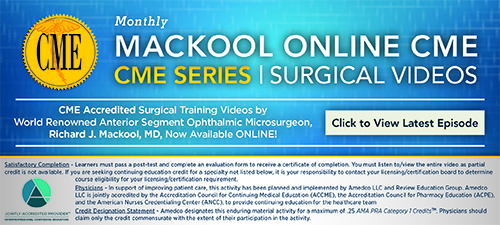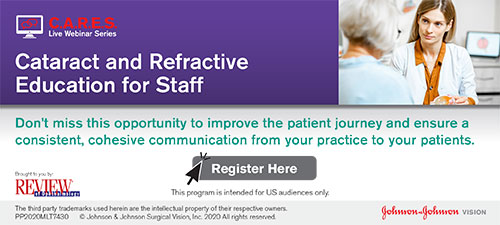| |
|
|
|
| Vol. 22, #4 • Monday, January 25, 2021 |
|
JANUARY IS GLAUCOMA AWARENESS MONTH
|
|
|
| |
|
Outcomes of Repeat SLT Treatments
Researchers aimed to characterize the intraocular pressure reduction, duration of effect and side effect profile of repeat selective laser trabeculoplasty used as standalone treatment for open-angle glaucoma. The secondary aim was to investigate covariates associated with treatment response to SLT.
The retrospective chart review conducted in a single-specialist practice included 52 patients with treatment-naïve OAG, who received three installments of 360-degree SLT as standalone glaucoma therapy. Where both eyes met the inclusion criteria, only right eye data was used for analysis.
Researchers compared first, second and third SLT treatments for IOP reduction and effect duration. Eyes were classified as "treatment responders" if they had ≥20 percent IOP reduction four to eight weeks post-SLT compared with baseline. Effect duration was defined as the interval between SLT and the time point at which the surgeon decided inadequate IOP control necessitated repeat SLT. Individuals were excluded if they underwent intraocular surgery during the study period or received treatment with adjunctive ocular hypotensive medications.
Here were some of the findings:
• Mean age at first SLT (SLT1) was 58 years; half of the subjects were male and 92 percent were phakic.
• SLT1 and SLT3 resulted in mean 27 percent IOP reduction at four to eight weeks, while SLT2 led to 26 percent IOP reduction.
• Response rate (≥20 percent IOP reduction at four to eight weeks) was 79 percent for SLT1, 73 percent for SLT2 and 81 percent for SLT3, but the difference wasn’t statistically significant.
• Response to repeat SLT wasn’t significantly associated with previous SLT outcome.
• Effect duration was: following SLT1, 22.2 months; following SLT2, 33.8 months; and following SLT3, 28.9 months.
• Effect duration was significantly longer after SLT2 (p=0.0006) and SLT3 (p=0.0444) compared with SLT1.
• No significant associations were found between SLT response and gender, lens status or OAG subtype.
Researchers concluded that, for primary standalone treatment in OAG, initial and repeat SLTs produced comparable percentage IOP reduction, but repeat SLTs had longer duration of effect. They added that IOP response to SLT wasn’t predictive of IOP response to subsequent SLT treatments.
SOURCE: Wang P, Akkach S, Andrew NH, et al. Selective laser trabeculoplasty: outcomes of multiple repeat treatments. Ophthalmol Glaucoma 2021; Jan 8. [Epub ahead of print.]
|
|
|
|
|
| |
|
RVP After Anti-VEGF Therapy in RVO-Related Macular Edema
Investigators wrote that, while the pathogenesis leading to retinal vein occlusion is unclear, mechanical compression, thrombosis and functional contractions of veins are discussed as reasons for the increased resistance of venous outflow. Investigators evaluated changes in retinal venous pressure following intravitreal injection of an anti-vascular endothelial growth factor agent to determine the effect on RVO-related macular edema.
Twenty-six patients with RVO-related macular edema (16 branch RVOs and 10 central RVOs, ages 72.5 ±8.8 years) who visited the investigators’ hospital were included in the prospective study. Visual acuity, intraocular pressure, central retinal thickness determined by macular optical coherence tomography, and RVP measured using an ophthalmodynamometer were obtained before intravitreal injection of ranibizumab and one month later.
Comparison of BRVOs and CRVOs showed that VA was significantly improved by a single injection in BRVOs (p<0.0001; p=0.1087 for CRVOs), but CRT and RVP were significantly decreased without significant difference in IOP after treatment in both groups (p<0.0001).
Investigators wrote that anti-VEGF treatment resulted in a significant decrease in RVP, although RVP remained significantly higher than IOP. They added that an increased RVP plays a role in the formation of macula edema, so reducing it is desirable.
SOURCE: Kida T, Flammer J, Konieczka K, et al. Retinal venous pressure is decreased after anti-VEGF therapy in patients with retinal vein occlusion-related macular edema. Graefes Arch Clin Exp Ophthalmol 2021; Jan 15. [Epub ahead of print].
|
|
|
|
|
|
|
| |
|
Low-concentration Atropine for Myopia Progression
Scientists evaluated the effect of age at treatment and other factors on the treatment response to atropine in the Low-concentration Atropine for Myopia Progression (LAMP) study, as part of a secondary analysis from a randomized trial.
Participants included 350 children, ages 4 to 12 years old (randomization was stratified by age and gender) originally assigned to receive 0.05%, 0.025%, 0.01% atropine or placebo once daily in both eyes, who completed two years of the LAMP study. In the second year, the placebo group was switched to 0.05% atropine.
Change in spherical equivalent and axial length over two years were evaluated by generalized estimating equations in each treatment group. Other factors evaluated included age at treatment, gender, baseline refraction, parental myopia, time outdoors, diopter hours of near work and treatment compliance.
Here were some of the findings:
• In the 0.05%, 0.025%, and 0.01% atropine groups, younger age was the only factor associated with SE progression (coefficient=0.14, 0.15 and 0.20, respectively) and AL elongation (coefficient=-0.10, -0.11 and -0.12, respectively) over two years; the younger the subject age, the poorer the response.
• At each year of age from 4 to 12 across the treatment groups, higher-concentration atropine showed a better treatment response, following a concentration-dependent effect (p<0.05).
• The mean SE progression in 6-year-old children using 0.05% atropine (-0.90D; CI, -0.99 to -0.82) was similar to that of 8-year-old children using 0.025% atropine (-0.89D; CI, -0.94 to -0.83), and 10-year-old children using 0.01% atropine (-0.92D; CI, -0.99 to -0.85). All concentrations were well-tolerated at all age groups.
Scientists found that younger age was associated with poor treatment outcomes with low-concentration atropine 0.05%, 0.025% and 0.01%. They added that, among atropine concentrations studied, younger children required the highest concentration, 0.05%, to achieve a reduction in myopic progression similar to older children on lower concentrations.
SOURCE: Li FF, Zhang Y, Zhang X, et al. Age effect on treatment responses to 0.05%, 0.025%, and 0.01% atropine: Low-concentration Atropine for Myopia Progression (LAMP) Study. Ophthalmology 2021; Jan 7. [Epub ahead of print].
|
|
|
|
|
| |
|
Recurrence of ME in BRVO Following Discontinuation of Anti-VEGF
Researchers identified factors predicting the recurrence of macular edema following the discontinuation of intravitreal anti-vascular endothelial growth factor injection in patients with branch retinal vein occlusion.
This retrospective study included subjects who had discontinued injections at three months after the final bevacizumab injection due to fully resolved macular edema. Fifty-two eyes meeting the criteria were included and divided into two groups (“Recurrence” and “No Recurrence”). Researchers analyzed clinical features and measurements of retinal thickness at the time of the diagnosis and when the decision to stop injections was made (stopping point).
Here were some of the findings:
• At the stopping point, the No Recurrence group showed a thinner parafoveal inner retina, better best-corrected visual acuity and lower incidence of ellipsoid zone disruption in multivariate logistic regression analysis (all p<0.05).
• Parafoveal inner retinal thinning of more than 30 μm, when compared with the corresponding region of the fellow eye or the unaffected region of the affected eye, was significantly related to less recurrence of macular edema.
Researchers determined that thinning of the parafoveal inner retina, as well as better vision and intact outer retinal layers were associated with a lack of recurrence of macular edema. They added that the findings suggested that inner retinal atrophy after BRVO may result in a reduction in oxygen demand in the affected retinal tissue and less production of VEGF.
SOURCE: Lee GW, Kang SW, Kang MC, et al. Associations with recurrence of macular edema in branch retinal vein occlusion following the discontinuation of anti-vascular endothelial growth factor. Retina 2021; Jan 13 [Epub ahead of print].
|
|
|
|
|
|
|
|
| |
Complimentary CME Education Videos
|
|
|
|
|
Industry News
Alcon Launches Precision1 for Astigmatism Contact Lenses
Alcon announced the U.S. launch of Precision1 for Astigmatism, a daily disposable, silicone hydrogel contact lens. The lens, which uses the Water Gradient Technology of Dailies Total1, features the Precision Balance 8|4 lens design for a stable lens-wearing experience, the company says. The lenses feature Smartsurface Technology, a permanent micro-thin layer of moisture that steps up from 51 percent water at the core to greater than 80 percent water at the outer surface.
Read more.
SynergEyes iD Hybrid Contact Lenses Launch
SynergEyes introduced its next generation of hybrid contact lenses, SynergEyes iD, for patients with astigmatism, presbyopia, hyperopia and myopia. The company says the hybrid lenses are designed to fit patients’ unique ocular anatomy utilizing keratometric readings, HVID and refraction. A patient’s corneal diameter and curvature drive the specific lens design, with new linear skirts following the linear shape of the sclera, SynergEyes adds. The multifocal lens uses a proprietary extended depth-of-focus design from the Brien Holden Vision Institute. Learn more.
US Ophthalmic Introduces Eyer Portable Retinal Camera
US Ophthalmic has introduced the Eyer Portable Retinal Camera, which connects to a smartphone for images of the retina. The company says the device can “detect fundus disease at a lower cost than conventional methods.” The device, which can be used for telemedicine exams, illuminates and images the retina. It connects to a smartphone's camera, and an app sends the images over the internet to Eyer Cloud. The device further offers: panoramic images of more 110 degrees; iCloud connectivity; telemedicine capability; anterior and posterior segment imaging; and 12 megapixel images.
B+L Completes Enrollment of First Phase III Study for NOV03, Announces Scientific Data on Infuse SiHy Daily Disposable CLs
Bausch + Lomb announced the first of two Phase III studies evaluating NOV03 as a first-in-class investigational drug with a novel mechanism of action to treat the signs and symptoms of dry eye associated with meibomian gland dysfunction has completed enrollment with a total of 599 participants. Read more.
In addition, the company announced that two poster presentations will feature data on the new Bausch + Lomb Infuse silicone hydrogel daily disposable contact lenses during the virtual Global Specialty Lens Symposium annual meeting, January 21 to 23. Bausch + Lomb will offer attendees the opportunity to participate in a presentation about its Zenlens scleral lenses. Read more.
| |
Advertisement
|
|
|
|
Keeler and Merakris Partner
Keeler announced a partnership with Merakris Therapeutics, a developer of regenerative health care products. The company says its dehydrated amniotic membrane product, Opticyte Amniotic Ocular Matrix technology is based on a manufacturing process intended to retain extracellular matrix properties and structures. The company says the amniotic membrane is processed without harsh chemical reagents that may cause irritation. The Opticyte Amniotic Ocular Matrix comes in 8 mm, 10 mm, 12 mm and 14 mm circular grafts along with 1x1 cm and 1x2 cm surgical repair grafts.
|
|
|
|
|
|
| |
Review of Ophthalmology® Online is published by the Review Group, a Division of Jobson Medical Information LLC (JMI), 19 Campus Boulevard, Newtown Square, PA 19073.
To subscribe to other JMI newsletters or to manage your subscription, click here.
To change your email address, reply to this email. Write "change of address" in the subject line. Make sure to provide us with your old and new address.
To ensure delivery, please be sure to add reviewophth@jobsonmail.com to your address book or safe senders list.
Click here if you do not want to receive future emails from Review of Ophthalmology Online.
Advertising: For information on advertising in this e-mail newsletter or other creative advertising opportunities with Review of Ophthalmology, please contact sales managers Michael Hoster, Michele Barrett or Jonathan Dardine.
News: To submit news or contact the editor, send an e-mail, or FAX your news to 610.492.1049
|
|
|
|
|
|
|
|